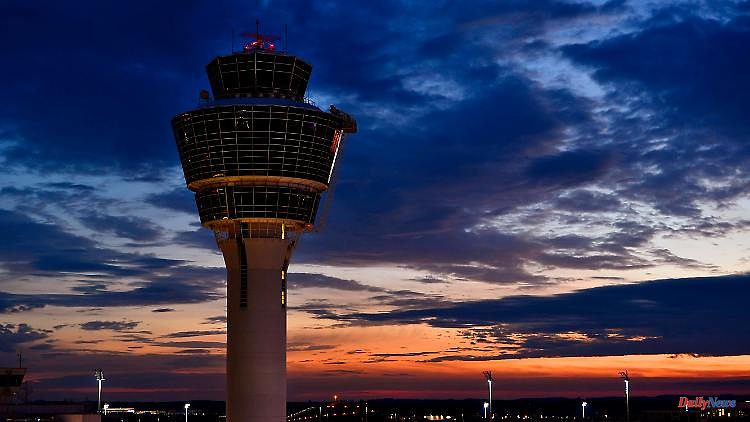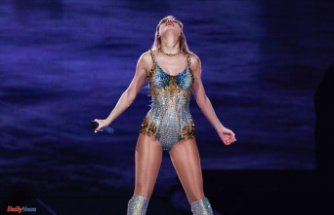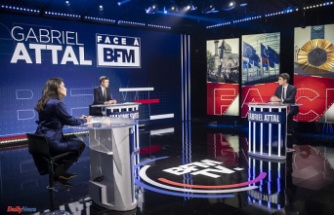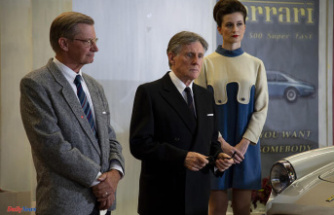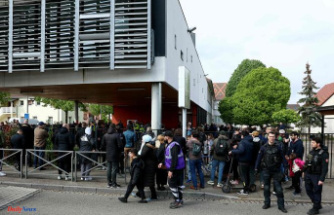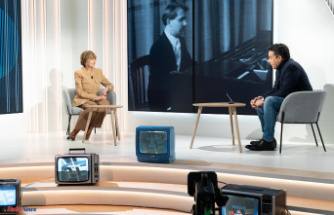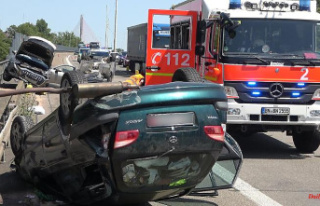Wall-sized mosaics, hanging mountains, flickering neon spirals fill museums, public buildings and public spaces. The art of the Allgäu artist Stephan Huber can be seen in Frankfurt, Hanover and Hamburg. Islands, clouds, mountains, maps - his sculptures, installations and light boxes provide wanderlust. At the same time, they are connected to their homeland, reminding the audience of the place where they are at the moment. Just like his hanging fountain at the airport in Munich. It should now be dismantled and destroyed. If the fountain is to continue to gush in the future, Huber will have to look for sponsors himself. The 70-year-old artist spoke to ntv.de: about the disappearance of an infernal machine, fatigue, a desire to work and a development that stunned him.
ntv.de: Your hanging fountain "The Alps" at Munich Airport has been delighting visitors since 1992. Now he should be taken down. What happened?
Stephan Huber: It has to be restored, which is normal after such a long time. But the costs, namely electricity and water, which amount to around 8000 euros a year, are now too expensive for the airport company. The financial slump caused by Corona is used as an argument. Art is the first thing up for grabs. The 1.2 kilometer light installation "Lightway" by Keith Sonnier has already been switched off.
How did you find out about the imminent disappearance of your work?
I got a call from the airport press officer. He informed me that the airport can no longer pay the costs for the restoration, water and electricity.
The airport company is also responsible for the maintenance?
The work belongs to the airport. Actually, the city of Munich and the building department, which do a lot of art in public buildings, would also be responsible for 30 percent. But no one feels really responsible. I was resigned to the well being dismantled. Then more and more artist friends asked me if I was "crazy" to dismantle this fountain. He was like a "baroque infernal machine" and had to stay.
So the only way to save "The Alps" at the airport is to do it yourself?
Yes. If I want the work to be preserved, I have to look for sponsors myself for the restoration and to cover the annual costs. A completely absurd situation, but the alternative would be: dismantle.
And then the work disappears in some boxes?
No, it will be thrown away.
I beg your pardon?
Well, I think that would be better than the idea of hanging the mosaic of the Alps somewhere else in an airport hotel. I definitely don't want any leftovers to be used. Better the fountain including the mosaic is completely destroyed. That was just an episode in public space.
That sounds so clear. Could you really live with your artwork being destroyed?
No, but I have to live with it. I've seen that in other situations. In Magdeburg, for example, a job in the foyer of the building could not be obtained after the sale of a property. This is a typical problem of art in public space.
What does that do to you as an artist?
It's a bit exhausting. Because the work has been open to the public for 20 years or longer. You don't belong to me anymore. And suddenly, as an artist, you get all the responsibility back. For example, I now have to talk to the people in charge in the city of Munich as to whether they might assume the costs of operation. After all, Munich is a city of culture. It can't be that airports all over the world look the same, with the same shops and the art is being dismantled. That fits with the massification of society. I have only one moral leverage...
With this experience, do you still enjoy making art?
Yes, but rather in a protected space than in public. I just now know what kind of demands are placed on fragile works of art from the outside. That is to complicated for me. I love doing art and exhibitions. As is currently the case in Munich's CAS, the Center of Advanced Studies. A completely new situation for me because it is a functioning, institutional, university building. I have decorated the entire villa with my art, where lectures take place and daily work takes place.
For the "Shining" exhibition, you measure the world, take visitors to your parents' house and designed small chambers of wonder. They mix pop and high culture, you can immerse yourself in sophisticated maps. You question boundaries - are you just reaching your own limits?
I would say yes and no. What concerns me the most at the moment is the struggle that is taking place in the art system in this country. An excessive demand and complete overload from the outside, which is imposed on the artists.
Can you describe that in more detail?
In my opinion, there is a certain power pole of functionaries, curators and the Federal Cultural Foundation who want politically correct art and who exploit art as a political platform. However, the majority of artists and museum people are not interested in collective sociological experiments. They are still concerned with autonomous, subjective authorship. But there is this unbelievable hype about the collective.
Can you give an example?
At the Documenta in Kassel, works by collectives can be seen almost exclusively. There's a lot of mediocrity there. That's the problem with collectives, ultimately it's a program of weakness. In my 14 years as a professor at the Munich Art Academy, there was not a single exhibition by collectives that went beyond the quality of individual settings.
Why is that?
As a collective you meet in the middle. Most of the time, a harmless aesthetic that doesn't bother anyone is the result. Radicality in art comes from personal, subjective imagination. Collectives will not prevail because authorship is reduced to absurdity. In the end, functionaries or curators are not allowed to determine the artistic work. The best antipode to the Kassel Documenta is the Venice Biennale. 80 percent of the works by female artists are shown there, which are mood-oriented and personal. I am in Venice with my whole soul and not with this ethno-kitsch or pathetic propaganda work of some collectives who want to make a social model for late capitalism in the 21st century out of rural, communal rice barns. I'm stunned.
Now one could try the narrative of the old white artist. The signs of the times are different and maybe not yours anymore...
Sure, I'm an artist who's 70 and I know it. And I think primarily Eurocentric - that's what I grew up with. There are allegations that are true. But what is crucial is that art is an aesthetic entity that cannot be explained solely through language. In art there are meta-levels or subtexts that make works vibrate. Then the art has the quality! Art as a metaphor for social change is dull. This has nothing to do with white old men or black boys. Art is purposeless and thus has the greatest freedom that exists in society. Young artists I know have a similar view, they would only put it in a hipper way (laughs).
Surely you just couldn't create any more works of art?
No, first of all I would be bored. Then making art is also a pleasurable affair. I still have this urge to work aesthetically, to share certain thoughts.
Once an artist, always an artist?
Absolutely. I just had a death in my close family circle, so many memories come up. Translating these memories into images has always been my artistic practice. And as long as I'm still able to find pictures that are understood and that carry an intensity, I'm still young.
Juliane Rohr spoke to Stephan Huber
"Shining", until July 31, CAS, Seestraße 13, 80802 Munich, registration here

